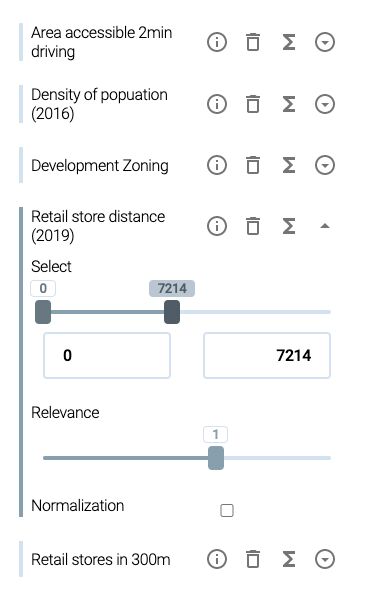Retailers often consider several location characteristics when deciding where to open a new store or expand their existing business, e.g. demographics of residential and workers, foot traffic and vehicular traffic, accessibility, competition , cost of the retail space and zoning regulations.
Such information are preprocessed our platform https://app.udl.ai/ - they can easily be loaded, viewed and also extended with custom information. But how to work with such data to create custom spatial strategies in form of an index?
To create an index of relevant location characteristics for retail, each factor is typically assigned a weight based on its importance to the retailer's business. The weights can vary depending on the specific retail business and its objectives, but generally, the more critical the factor is to the success of the business, the higher the weight it is given.
For example, if foot traffic is crucial to a retail business, it may be given a higher weight than zoning regulations, which may have a lesser impact on the business's profitability. Once the weights are assigned, each factor is typically scored and standardized, so that they can be compared and combined into an overall index score.
One common method of creating an index is to use a weighted average, where each factor's score is multiplied by its assigned weight and then added together. For instance, if the demographic score has a weight of 30%, foot traffic score has a weight of 25%, accessibility score has a weight of 20%, competition score has a weight of 15%, and safety score has a weight of 10%, then the overall index score can be calculated as follows:
Index Score = (0.3 x Demographic Score) + (0.25 x Foot Traffic Score) + (0.2 x Accessibility Score) + (0.15 x Competition Score) + (0.1 x Safety Score)
This formula produces an index score that ranges from 0 to 100, with higher scores indicating a more favorable location for the retailer. The specific weights assigned to each factor can vary depending on the retailer's priorities and objectives, as well as the unique characteristics of the local market. On udl.ai they can even be derived with statistical methods.
The great thing - results are instantly visible as map, can be queried and can be assigned to any potential new location or used in acquisition.
Like to test it - simply register on our platform and try it.
If you want to know more and to see how to use it for your business - do not hesitate to reach out.
Such information are preprocessed our platform https://app.udl.ai/ - they can easily be loaded, viewed and also extended with custom information. But how to work with such data to create custom spatial strategies in form of an index?
To create an index of relevant location characteristics for retail, each factor is typically assigned a weight based on its importance to the retailer's business. The weights can vary depending on the specific retail business and its objectives, but generally, the more critical the factor is to the success of the business, the higher the weight it is given.
For example, if foot traffic is crucial to a retail business, it may be given a higher weight than zoning regulations, which may have a lesser impact on the business's profitability. Once the weights are assigned, each factor is typically scored and standardized, so that they can be compared and combined into an overall index score.
One common method of creating an index is to use a weighted average, where each factor's score is multiplied by its assigned weight and then added together. For instance, if the demographic score has a weight of 30%, foot traffic score has a weight of 25%, accessibility score has a weight of 20%, competition score has a weight of 15%, and safety score has a weight of 10%, then the overall index score can be calculated as follows:
Index Score = (0.3 x Demographic Score) + (0.25 x Foot Traffic Score) + (0.2 x Accessibility Score) + (0.15 x Competition Score) + (0.1 x Safety Score)
This formula produces an index score that ranges from 0 to 100, with higher scores indicating a more favorable location for the retailer. The specific weights assigned to each factor can vary depending on the retailer's priorities and objectives, as well as the unique characteristics of the local market. On udl.ai they can even be derived with statistical methods.
The great thing - results are instantly visible as map, can be queried and can be assigned to any potential new location or used in acquisition.
Like to test it - simply register on our platform and try it.
If you want to know more and to see how to use it for your business - do not hesitate to reach out.
